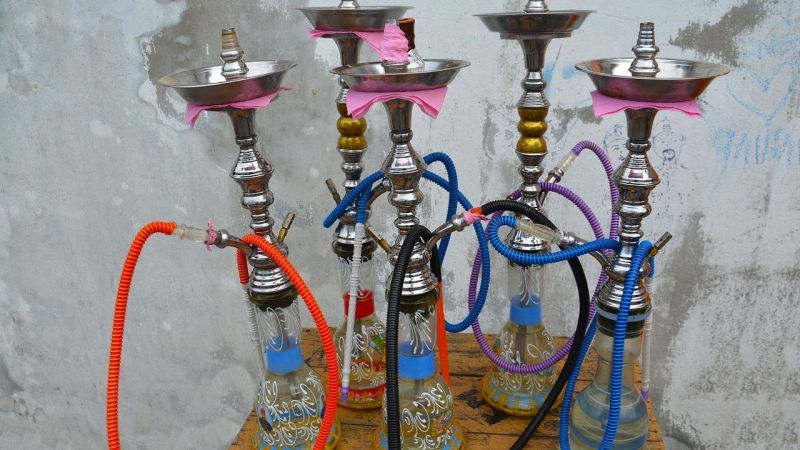Are Hookahs More Dangerous Than Cigarettes, or Does Misleading University Publicity Generate Inaccurate Reporting?
The sexiest discoveries are often the ones not found in the actual study.

When the press misrepresents scientific research, it is easy (and usually fair) to blame reporters who don't bother to read the study. But university publicity departments are also part of the problem, since they tend to hype results in an attempt to generate coverage, sometimes at the expense of the truth. A recent study of hookahs by researchers at the University of California, Irvine, provides a small but telling example.
According to a UCI press release distributed on Monday, the study found that hookah use "could be more dangerous than other forms of smoking." But that is not what the study, which was published in the journal Aerosol Science and Technology, actually found. While the hookahs tested in the study generated relatively large amounts of ultrafine particles, some volatile organic compounds, and carbon monoxide (mainly from the charcoal used to heat the tobacco mixture), the researchers report that "the chemical composition of the hookah aerosol" was "remarkably different" from cigarette smoke, which contains "at least 250" harmful chemicals, according to the National Cancer Institute.
While hookah smoke "is dominated by the glycerol and its thermal decomposition products in the gas phase, and by sugar-related molecules in the particle phase," the study says, cigarette smoke "is far more complex, reflecting the higher combustion temperature in the cigarette, which generates a huge diversity of toxic compounds, while the low temperature waterpipe process and the practice of adding sugared flavoring and glycerol results in particles that are less concentrated in many toxic compounds." (Emphasis mine.) On the whole, in other words, cigarette smoke contains more toxins and carcinogens than hookah smoke.
"Nevertheless," the researchers add, "aside from the significant exposure to carbon monoxide, hookah mainstream smoke is not without health hazard, considering the presence of large amount of glycerol decomposition products in the hookah mainstream smoke, such as acrolein and acetaldehyde, and benzene." There is a big difference between "not without health hazard" and "more dangerous than cigarette smoke," the impression left by the UCI press release.
The university compounded the confusion with a quotation from UCI chemist Veronique Perraud, the lead author of the study. "Hookah mainstream smoke—that which is directly inhaled by the user—has many toxic and harmful chemicals, such as nicotine, which can lead to tobacco addiction; irritating carbonyl compounds; and benzene, a known carcinogen," she said. "And due to the greater volume inhaled for every puff and the longer duration of a smoking session, the hookah oftentimes delivers a higher dose of those chemicals to the smoker."
Those statements accurately reflect Perraud's findings: Hookahs can deliver "a higher dose" of certain "toxic and harmful chemicals" than cigarettes do. But that does not mean they are more hazardous overall, which is the impression left by the claim that they are "more dangerous than other forms of smoking." I emailed Perraud to ask her about the way her findings were described but have not received a reply.
The misleading press release predictably led to misleading news reports. According to KGTV, the ABC station in San Diego, "a new study claims that hookah could be more dangerous than other forms of smoking." According to Patch, "one draw from a waterpipe can contain as many noxious substances as smoke from an entire cigarette." A Futurity headline about the study claims that "Hookah May Be Worse for You Than Cigarettes."
The study found that "the number of ultrafine particles inhaled in a single puff of hookah mainstream smoke is often equivalent to smoking more than one entire cigarette." Similarly, the levels of some volatile organic compounds were equivalent to "one or more entire cigarettes for a single puff of hookah smoke." The study also found that "the dose of CO [carbon monoxide] from a single waterpipe smoking session was equivalent to a dose of CO from 12 references cigarettes." But these comparisons do not carry over to all the "noxious substances" found in cigarette smoke, as the researchers pointed out.
The study tested hookahs with and without water to measure the effect of filtration. The researchers found that "very little filtration of the gas phase products is provided by the percolation of mainstream smoke through water." They say "our work combined with previous studies suggest[s] that significant amount[s] of toxic compounds will still reach the smoker's mouth when water is present in the bowl."
If you were under the impression that hookahs pose no health risks, or that water filtration is a highly effective way to eliminate potentially hazardous substances, this study will disabuse you of those notions. But it does not show that hookah users would be better off switching to cigarettes, which is what you might reasonably conclude from the UCI press release and the reports based on it.
Reporters often have trouble with the concept of relative risk, especially when it comes to tobacco products and e-cigarettes. They also tend to play up what they take to be the most startling implication of the research they cover, to better catch readers' eyeballs, even when that implication is erroneous. "Hookahs Are Even More Dangerous Than Cigarettes" is more counterintuitive, and therefore more interesting, than "Hookahs Are Less Dangerous Than Cigarettes, but That Does Not Mean They Are Harmless." Yet the latter statement has the advantage of being true.
Many, if not most, reporters will not take the time to read the scientific studies they write about. Given that reality, the people charged with translating researchers' findings into terms the average journalist can quickly digest have a special responsibility to get things right, even at the cost of making the study seem less sexy.


Show Comments (21)